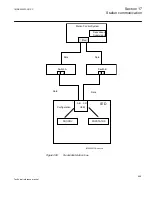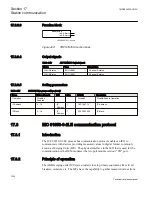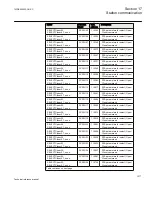
bytes), peer-to-peer communication, multiple communication media, low maintenance,
multivendor equipment, and low support costs. LonTalk supports the needs of
applications that cover a range of requirements. The protocol follows the reference
model for open system interconnection (OSI) designed by the International
Standardization Organization (ISO).
In this document the most common addresses for commands and events are available.
For other addresses, refer to section
It is assumed that the reader is familiar with LON communication protocol in general.
17.4.2
Principle of operation
The speed of the network depends on the medium and transceiver design. With
protection and control devices, fibre optic media is used, which enables the use of the
maximum speed of 1.25 Mbits/s. The protocol is a peer-to-peer protocol where all the
devices connected to the network can communicate with each other. The own subnet
and node number are identifying the nodes (max. 255 subnets, 127 nodes per one subnet).
The LON bus links the different parts of the protection and control system. The
measured values, status information, and event information are spontaneously sent to
the higher-level devices. The higher-level devices can read and write memorized
values, setting values, and other parameter data when required. The LON bus also
enables the bay level devices to communicate with each other to deliver, for example,
interlocking information among the terminals without the need of a bus master.
The LonTalk protocol supports two types of application layer objects: network
variables and explicit messages. Network variables are used to deliver short messages,
such as measuring values, status information, and interlocking/blocking signals.
Explicit messages are used to transfer longer pieces of information, such as events and
explicit read and write messages to access device data.
The benefits achieved from using the LON bus in protection and control systems
include direct communication among all terminals in the system and support for multi-
master implementations. The LON bus also has an open concept, so that the terminals
can communicate with external devices using the same standard of network variables.
Introduction of LON protocol
For more information, refer to LON bus, LonWorks Network in Protection and
Control, User’s manual and Technical description.
LON protocol
Configuration of LON
Lon Network Tool (LNT 505) is a multi-purpose tool for LonWorks network
configuration. All the functions required for setting up and configuring a LonWorks
1MRK505222-UUS C
Section 17
Station communication
1007
Technical reference manual
Summary of Contents for Relion 670 series
Page 1: ...Relion 670 series Line differential protection RED670 ANSI Technical reference manual...
Page 2: ......
Page 40: ...34...
Page 50: ...44...
Page 60: ...54...
Page 126: ...120...
Page 384: ...378...
Page 496: ...490...
Page 556: ...550...
Page 602: ...596...
Page 620: ...614...
Page 794: ...788...
Page 864: ...858...
Page 988: ...982...
Page 998: ...992...
Page 1084: ...1078...
Page 1164: ...1158...
Page 1168: ...1162...
Page 1220: ...1214...
Page 1230: ...1224...
Page 1231: ...1225...








































